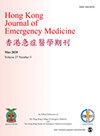奥氮平与咪达唑仑用于兴奋性谵妄综合征院前治疗的安全性和有效性的回顾性研究
IF 0.8
4区 医学
Q4 EMERGENCY MEDICINE
引用次数: 1
摘要
目的:评价奥氮平与咪唑安定治疗兴奋性谵妄综合征的安全性和有效性。方法:对2016年至2019年由救护人员治疗的兴奋性谵妄综合征患者进行回顾性分析。选择的药物是根据消防局的护理人员方案(2016年1月至2018年10月肌肉注射咪唑安定,2018年10日至2019年12月肌肉注射奥氮平)提供的。主要结果是至少经历一次不良事件的患者比例。次要结果是镇静成功率。结果:本研究共纳入201例患者。99名患者在院前接受了咪达唑仑治疗,102名患者接受了奥氮平治疗。31名患者在到达A&E后出现不良事件,包括格拉斯哥昏迷评分降至8分以下(90%)、低血压(6%)、,和气道阻塞(3%):咪达唑仑组17例(17%的患者;1例气道阻塞和16例格拉斯哥昏迷量表评分低于8),奥氮平组14例(14%的患者;2例低血压和12例格拉斯哥昏迷评分低于8(p=0.41),与奥氮平组的79例(77%)相比(p=0.020)。在酒精中毒亚组中,咪达唑仑的不良事件比奥氮平多,具有统计学意义(12vs2,p=0.03)。急性酒精中毒患者使用咪达唑仑的不良事件较多,尤其是过度镇静和气道损害。在资源有限的院前环境中,奥氮平是一种更安全的选择,并且不可能总是区分根本原因。本文章由计算机程序翻译,如有差异,请以英文原文为准。
A retrospective study on the safety and effectiveness of olanzapine versus midazolam for pre-hospital management of excited delirium syndrome
Objective: To evaluate the safety and effectiveness of olanzapine compared to midazolam for the pre-hospital management of excited delirium syndrome. Methods: A retrospective review of patients who were treated by ambulance crew for excited delirium syndrome from 2016 to 2019 was performed. The drug of choice was given per Fire Service Department’s paramedic protocol (intramuscular midazolam January 2016 to October 2018 and intramuscular olanzapine October 2018 to December 2019). The primary outcome was the proportion of patients experienced at least one adverse event. The secondary outcome was the successful sedation rate. Results: A total of 201 patients were included in the study. Ninety-nine patients had pre-hospital midazolam and 102 received olanzapine. Thirty-one patients experienced adverse event after arrival to A&E, including a drop of Glasgow Coma Scale score to below 8 (90%), hypotension (6%), and airway obstruction (3%): 17 (17% patients; 1 airway obstruction and 16 Glasgow Coma Scale score below 8) in midazolam group and 14 (14% patients; 2 hypotension and 12 Glasgow Coma Scale score below 8) in olanzapine group (p = 0.41). Sixty-eight patients (69%) in midazolam group achieved successful sedation, compared with 79 (77%) in olanzapine group (p = 0.20). More adverse events were seen with midazolam than olanzapine in alcohol intoxication subgroup with statistical significance (12 vs 2, p = 0.03). Conclusion: Both midazolam and olanzapine can achieve a satisfactory success rate of sedation. More adverse events are associated with midazolam use in patients with acute alcohol intoxication, especially over-sedation and airway compromise. Olanzapine would be a safer choice in the pre-hospital setting where the resource is limited, and differentiation of underlying causes is not always possible.
求助全文
通过发布文献求助,成功后即可免费获取论文全文。
去求助
来源期刊

Hong Kong Journal of Emergency Medicine
EMERGENCY MEDICINE-
CiteScore
1.50
自引率
16.70%
发文量
26
审稿时长
6-12 weeks
期刊介绍:
The Hong Kong Journal of Emergency Medicine is a peer-reviewed, open access journal which focusses on all aspects of clinical practice and emergency medicine research in the hospital and pre-hospital setting.
 求助内容:
求助内容: 应助结果提醒方式:
应助结果提醒方式:


